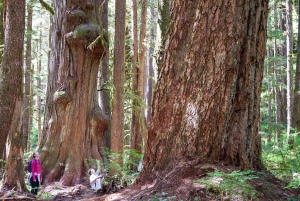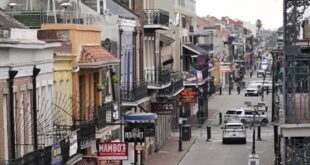
The two-lane logging road snakes through the forest — on one side, glimpses of silver river through the willow branches, skeletal maples draped in velvety green moss and a forest of naked poplars. On the other, dripping rock covered with shiny wet ferns, the occasional forked cataract of frothy water spilling down the rock face into the ditch.
We cross a high, narrow wooden bridge over a rain-fat, brown, fast-moving river, and then we’re on gravel and dodging potholes that are sometimes just pools and elsewhere road-wide fissures that we have to slow to a crawl to get over.
Finally, after crossing another tiny bridge, we see a wooden sign pointing to two trails, one on the up-slope from the road, the other down into a valley.
This is Avatar Grove, testament to a genius bit of marketing by the Ancient Forest Alliance, a Victoria-based environmental group.
Photographer and alliance co-founder TJ Watt discovered this 50-hectare stand of 80-metre-tall old growth Douglas-fir and western red cedar, about 12 kilometres outside of Port Renfrew, while looking for big trees in late 2009. Two months later, he came back to show alliance co-founder Ken Wu and found flagging tape marking logging boundaries.
The two immediately sprang into action. Wu came up with the moniker Avatar Grove, after the movie about saving old-growth forest on an alien planet, which had just come out.
The environmentalists hosted tours of the grove and built alliances with the local business community, which now bills the Renfrew area as the tall-tree capital of the country.
It worked — the grove has been protected as an old-growth management area since February 2012 and is no longer at risk of being logged.
Now it’s considered a forest recreation site, with a total of about two kilometres of trail built by volunteers — a rough assembly of stairs, rocks, gnarly tree roots and small boardwalks.
In March, when we visited, the earth was spongy with rainwater and rotted logs, rising steeply on one side of the road through a forest of huge primordial cedars, towering firs, softly rotten fallen trees, and huckleberries just starting to sprout leaves.
Eventually, the upper route leads to “Canada’s gnarliest tree,” surely an arbitrary designation, but impressive nonetheless. My nine- and 11-year-old daughters and I stood at the base and looked up at its huge gnarlyness, sticking out our tongues to catch falling raindrops.
On the lower side, there was a warning sign that the trail was closed because of damage from falling trees and winter storms. Just down from a viewing deck, we could see where a tree had crashed onto a boardwalk at the foot of a staircase, damaging both. (The trail has since been repaired by a team of volunteers.)
We found another route down and picked our way along the boardwalks in an area that levelled out before a ravine. The rain hadn’t stopped, but we were wearing red ponchos that kept us dry, although they made it hard to look up and take in the impressive canopy.
Coming back in summer crossed our minds, but it seemed appropriate somehow to see this place in the rain, since that’s what made it this green, mystical and wild haven.
On the way back, we stopped at the Pacheedaht First Nation’s beach campsite to check it out, and ended up skipping the impossibly flat stones that seemed to be everywhere, while watching a lone surfer far, far out, like a black shiny seal on a distant breaker. The surfers seemed to be the only other “tourists” around on this late-March weekday, although when we emerged from Avatar Grove, we were surprised to see a black late-model sedan with Washington plates parked on the gravel road in front of our car — more evidence of the tall-tree campaign’s success.
Back at the waterfront cabin we had rented through Sooke-based Handsome Dan’s, the forested far shore was starting to emerge from the thick white shroud in which Port San Juan had been enveloped since we arrived, leaving white wisps of fog amidst the green, like Halloween cobwebs stuck in a Christmas wreath.
Half an hour later, the whole was enclosed again in white, only the skinny firs that towered up from the slope in front visible.
This West Coast game of peek-a-boo continued all afternoon, although the rain eventually turned to a soft misting that signalled it might be time to get outside again.
The day before, I took a walk into “town.” Port Renfrew is a collection of neighbourhoods spread over the seashore, river estuary and the West Coast Road. There are houses on both sides of Parkinson Road, but many of the couple of hundred year-round residents live down by the water in what’s called Beach Camp, a former logging camp that replaced a logging railyard rendered obsolete by truck logging.
Beach Camp, where electricity apparently arrived as late as 1958 — almost 100 years after Europeans first moved into the area — is a ragtag collection of everything from what look to be 1940s-era modest cottages to the odd 1980s split level, a few recently built homes and out and out mouldering shacks with disintegrating porches and debris piling up in their small front yards. In the centre is a tidy park with newish-looking playground equipment, including a zip line.
Not a soul was around, but the occasional truck sped by on the looping main street, the ubiquitous “slow down” signs clearly waging a losing battle. One cheeky sign said: “Why dent your cars with our kids and dogs?”
Rainwater was pooling in the streets in huge puddles that reached midway to my shins in places, making for an impressive splash when someone drove through. When I first looked down on Beach Camp from the main road, I wondered about the tsunami risk. Now I thought the town might be more in danger from inundation from above.
On the beach was driftwood like I’d never seen before — chunks of huge trees, roots and all, piled up like so much cordwood and slammed by waves that sent sprays of water shooting into the air. The weather evidently gets wild here, judging from the rock walls separating each property from the beach.
After a brief moment of sunshine, I watched a grey cloud moving fast toward the beach, carrying a rainshower that seemed to move horizontally, suddenly drenching me with large drops.
One surprising sight at Beach Camp was an old church with brown shingles and a tall bell tower, dating originally from 1875 in Somenos near Duncan, rebuilt in 1909, then moved to this spot at the entrance to Beach Camp in 1970. Called St. Mary’s Ecumenical Church, the wooden structure serves four faiths: Anglican, Roman Catholic, Presbyterian and United.
Across the street and up the hill a bit was the new-looking ambulance station on a gravel lot, where a woman just inside the large open doors gave me a friendly wave — the only human I saw on my walk in the rain, aside from the woman who sold me milk at the low-ceilinged, sparsely supplied General Store, and two children with faces pressed against an upper window of a home, clearly wishing for the rain to stop. On the other side of Parkinson from the ambulance station was a community centre with a library.
The General Store was about the only business that seemed to be open at that time of year, aside from the pub (I’ll get back to that later), some guesthouses, lodges, B&Bs and a tiny coffee shop called Tomi’s that advertises cappuccino. The adjacent gift store was closed for the season, as was the Coastal Kitchen, which offers locally sourced West Coast cuisine. A return in summer is definitely in order.
Logging was once the mainstay here but since 1990, when Fletcher Challenge shifted its centre of forest operations to Lake Cowichan, the focus has been on fishing and tourism.
The former seems to be thriving, at least during the summer halibut and salmon season — fishing charters make up about eight of the top 13 things to do in Port Renfrew on Trip Advisor, and one local told me about 35 charter boats operate out of the area — but other forms of tourism are making gains, too.
We were staying in one of the privately owned Wild Coast Cottages, a luxe-rustic landscaped development — nicknamed Hobbitville by the locals for its small cabins — laid out artfully along the sloping, forested waterfront en route to Botanical Beach. Next door, and reached via a set of stairs, the new year-round 60-slip Pacific Gateway Marina was open for business, with work continuing on an on-land boat-storage area and other amenities.
It’s still a rough-hewn community, though, with as many signs for excavating services as tourism-related businesses, and lots of slash piles, clearcuts and seedy-looking properties slowly being consumed by the ubiquitous moss. There is no cell service — I did see a phone booth — and no year-round gas station, although one is supposed to open this summer. If Renfrew is going to be the next Tofino, as some believe, it has a way to go.
Yet there is spectacular natural beauty all around, from Botanical Beach just a short drive down the road to Avatar Grove, Sombrio Beach and the Juan de Fuca and West Coast trails, which attract hikers from around the world.
The 47-kilometre Juan de Fuca Trail runs between China Beach and Botany Bay just outside Port Renfrew, and includes strips of old growth forest.
The 75-kilometre West Coast Trail, which runs between Port Renfrew at the south end and Bamfield on the Alberni Inlet, owes its existence to the large number of shipwrecks near the entrance to the Strait of Juan de Fuca from the 1800s to early 1900s, which earned the area the name the Graveyard of the Pacific. The trail, created by the local First Nations, became a lifesaving route, then a popular tourist attraction for backpackers willing to brave its steep ravines in return for a view of pristine beaches and old-growth forests straight out of an Emily Carr painting.
Along with surfers, hikers headed to the two destination trails are a mainstay of the local tourism business — some accommodations cater specially to them, such as the tiny hikers’ huts along Parkinson Road and the West Coast Trail Lodge.
For a quintessentially West Coast experience but without the blisters, we waited for a sunny day — which felt like a miracle after two solid days of rain — and headed to Botanical Beach at low tide. (One of the advantages of staying here is that you can get to the beach quickly for a morning low tide.)
After trekking through a sometimes soupy woodland trail with glimpses of pounding surf below, we emerged onto the beach.
Near the treeline, the bird chorus competed with the roar of waves slamming with huge clouds of spray against the slate rock formations studded with tide pools. Perfectly round pools have been forged out of the rock by sea urchins, with anemones, sculpin, snails and gracefully waving seaweed fronds arrayed in the crystal-clear water.
We poked around for hours, letting the sun burn off our clammy dampness.
On the way back from Botanical Beach, we popped into the waterfront Renfrew Pub, whose jetty and wharf — piled with dock fingers being stored for the storm season — were visible from the deck of our cottage.
The original Port Renfrew Hotel operated from 1927 until it was destroyed by fire in 2003. It was replaced by a replica that left off the second floor of hotel rooms, opting for an impressive cathedral ceiling in the pub instead. Inside are several tables, a pool table and a wood stove where a fire was burning briskly, creating a warm, woodsy atmosphere on a cool spring day. (There is a wrap-around patio on the water side for summer.)
Once the hotel played a key role in the area, as a spot where loggers and mariners could collect mail and cheques, and cash them. There’s a funny story about the hotel, too. An Irishman called George Alexander MacFarlane was captain of a tugboat called the J.W.P. that worked the west coast of the Island in the 1930s. One day, he and his crew arrived at the Port Renfrew Hotel in search of liquid refreshment.
Alas, it was a Sunday, and a law had been passed prohibiting such establishments from selling liquor on Sundays. The crew wasn’t about to take no for an answer, however. As the story goes, they were in the process of hooking up their tow line to the hotel’s pilings when the whole palaver was shut down by the police.
After a bowl of the best seafood chowder I’ve ever eaten, I met John McDonald, a.k.a. Johnny Mac, a.k.a. Port Renfrew’s self-described unofficial mayor, a lanky guy with a long greyish beard who looked to be in his early 60s and put me in mind of a Klondike prospector. Very quickly, I learned three things about him: He lives in an RV, he competed in the Olympics for archery and he once did the West Coast Trail in 24 hours, while trying to beat the 18-hour record.
Johnny Mac said he’d been coming here since the 1970s and finally retired in the area a few years ago. He said the hiking crowd has been great for business in town, along with motorcyclists and others taking advantage of the now-paved road to Lake Cowichan to make a circle tour through the area from Victoria.
Johnny Mac is bullish about Port Renfrew’s future — he told me enthusiastically about the new sawmill the local First Nation, the Pacheedaht, are building, along with the new gas station expected by mid-summer. The B.C. government is also providing money for much-needed water and sewer upgrades, he said.
Johnny Mac even had his own spin on the weather, which he acknowledged can be cool, even in summer, because the port is prone to fog banks (although temperatures at nearby Lizard Lake can get up to 30 C). “We’ve always got the air-conditioner on,” he said with a grin.
The next day we made our final stop, Sombrio Beach, which I’ve wanted to see for years but haven’t, though it’s less than two hours from Victoria. I remember the controversy in the mid-1990s when squatters who had lived at the beach for years were turfed out so the area could become part of a provincial park. One family raised 11 children at the beach — the subject of a documentary called Sombrio by Nanaimo filmmaker Paul Manly.
A tiny tribute to one of the family’s sons, Jesse Oke, a talented surfer who died several years ago, is visible on a small metal sign tacked to a tree at the beach.
A short, steep, rough road took us to a large parking lot, and we followed an easy trail down to the beach. To the right is a suspension bridge over the river (my nine-year-old did an actual happy dance when she saw it). Scattered around the area are wooden tent platforms, food-cache bins and composting toilets for hikers doing the Juan de Fuca Trail.
To the left of the river, the beach curves out with stretches of sand, pebbles and large cobbles, overhung by giant old-growth trees. We watched the surfers for a while, but there was little action — about a dozen little black-hooded heads bobbed, waiting for the right wave, which didn’t seem to come very often. They were in three areas, each with its own name: First, Chickens and Second. (Chickens is the beginner area, natch.) The water was chilly, but surfers can stay warm for up to two hours in a good wetsuit, one told me.
After looking for remains of the old squatter homes and finding only a stone hearth, we wandered down the beach in search of a cave with a waterfall we had heard about. After a few false starts following creeks into dense foliage, we saw a couple emerging from a trail next to a fast-flowing creek. Yes, they said, this was the way to the waterfall.
We walked up the creek until the rock walls enclosed us on both sides and we felt a rush of cool wind and light spray of water from the cascade dropping from about six or seven metres above us. It was an indescribable rush — and a fitting end to a wet and wild week in Port Renfrew.
[ad_2]You can read more of the news on source
 Travelsmart
Travelsmart


